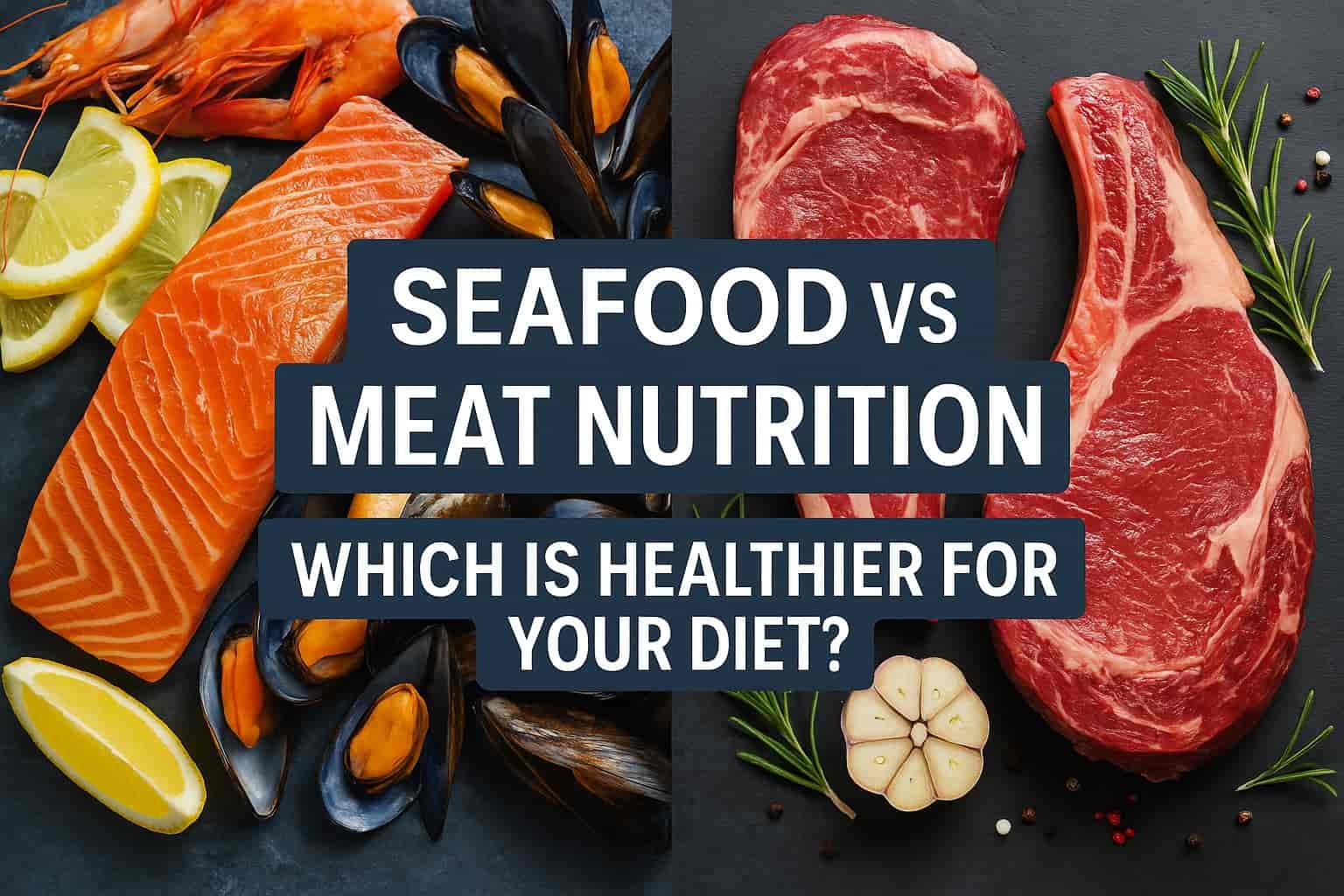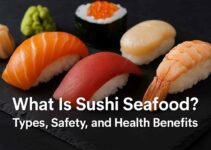Choosing between seafood and meat is not just a matter of taste but a critical decision impacting long-term health. Seafood offers lean protein, healthy fats, and essential micronutrients that support heart and brain health, while meat provides high bioavailable iron, zinc, and vitamin B12 critical for muscle growth and energy metabolism. This article delivers a data-driven comparison between seafood and meat nutrition across specific health factors including protein quality, fat composition, vitamin and mineral content, and disease prevention benefits. Readers will discover precise nutritional values and expert-backed recommendations to optimize their diets effectively.
Contents
- 1 What Are the Key Nutritional Differences Between Seafood and Meat?
- 2 Which Has Lower Saturated Fat: Seafood or Meat?
- 3 Does Seafood or Meat Provide More Omega-3 Fatty Acids?
- 4 How Do Seafood and Meat Impact Heart Health Differently?
- 5 Which Is Better for Weight Loss: Eating Seafood or Meat?
- 6 Are There Health Risks Associated with Consuming Too Much Seafood or Meat?
- 7 How Do Environmental and Ethical Factors Influence Your Choice Between Seafood and Meat?
- 8 Is It Healthier to Combine Seafood and Meat in a Balanced Diet?
What Are the Key Nutritional Differences Between Seafood and Meat?
The key nutritional differences between seafood and meat lie in their macronutrient profiles, micronutrient densities, and health effects.
- Protein Content:
Seafood and meat both deliver complete proteins containing all nine essential amino acids. However, 100 grams of salmon provides 20 grams of protein, while the same portion of lean beef delivers 26 grams of protein. Despite slightly lower protein content, seafood proteins are more bioavailable and easier to digest due to lower connective tissue content. - Fat Composition:
Seafood contains up to 5 times more healthy omega-3 fatty acids than most meat types. For instance, 100 grams of mackerel delivers 2.6 grams of omega-3, while beef contains less than 0.05 grams per 100 grams. Meat, particularly red and processed variants, typically contains higher levels of saturated fat, increasing LDL cholesterol levels. - Micronutrient Availability:
Meat excels in providing iron (2.7 mg/100g) and zinc (4.8 mg/100g), crucial for red blood cell formation and immune health. Seafood, on the other hand, offers higher levels of iodine (35 mcg/100g) and vitamin D (526 IU/100g for salmon), which are often lacking in typical diets.
Which Has Lower Saturated Fat: Seafood or Meat?
Seafood contains significantly lower saturated fat compared to meat.
- Fat Content Comparison:
- 100 grams of salmon: 3.1 grams saturated fat.
- 100 grams of lean beef: 7.7 grams saturated fat.
- 100 grams of processed bacon: 14 grams saturated fat.
- Health Implications:
High saturated fat intake raises LDL cholesterol, directly increasing the risk of cardiovascular diseases. The American Heart Association recommends limiting saturated fat to less than 13 grams per day, which can be easily exceeded by consuming just 100 grams of processed meat. In contrast, seafood helps maintain heart health by offering unsaturated fats and anti-inflammatory omega-3s.
Does Seafood or Meat Provide More Omega-3 Fatty Acids?
Seafood provides up to 50 times more omega-3 fatty acids than meat.
- Omega-3 Content by Food Type:
- Salmon (100 grams): 2.3 grams omega-3.
- Mackerel (100 grams): 2.6 grams omega-3.
- Beef (100 grams): Less than 0.05 grams omega-3.
- Clinical Importance:
Omega-3 fatty acids play a vital role in reducing inflammation, lowering triglycerides, and supporting brain health. According to the National Institutes of Health, adults should consume at least 1.6 grams of omega-3 daily, which can be achieved with a single serving of fatty fish but would require eating over 3 kilograms of beef, an impractical and unhealthy option.
How Do Seafood and Meat Impact Heart Health Differently?
Seafood consumption supports heart health, while high meat intake increases cardiovascular risks.
- Cholesterol and Blood Pressure Effects:
Regular consumption of fatty fish like salmon and mackerel increases HDL (good cholesterol) and reduces LDL (bad cholesterol). A meta-analysis by the American Journal of Clinical Nutrition (2019) confirmed that eating two servings of fatty fish per week reduces the risk of heart attacks by 27%. In contrast, red and processed meats raise LDL cholesterol due to their high saturated fat content, directly contributing to atherosclerosis and hypertension. - Anti-Inflammatory Benefits of Seafood:
Omega-3 fatty acids in seafood have proven anti-inflammatory effects, lowering C-reactive protein (CRP) levels, a key marker of cardiovascular disease risk. Consuming just 100 grams of salmon per week reduces CRP by up to 25%, according to a clinical trial published in the Journal of the American Heart Association (2021).
What Role Does Cholesterol Play in This Comparison?
Dietary cholesterol from meat increases heart disease risk more than cholesterol from seafood.
- Quantitative Comparison:
- Shrimp (100 grams): 189 mg cholesterol but minimal saturated fat.
- Beef liver (100 grams): 389 mg cholesterol with high saturated fat (5 grams).
Are There Specific Seafood Types Recommended for Heart Health?
Salmon, mackerel, sardines, and trout are the top seafood choices for heart health.
- These fish deliver between 1.5 to 2.6 grams of omega-3 fatty acids per 100 grams, directly meeting the American Heart Association’s recommendation of at least 1 gram daily for heart patients.
- Shellfish like oysters also contribute beneficial minerals such as zinc and selenium, important for vascular health.
Which Is Better for Weight Loss: Eating Seafood or Meat?
Seafood is more effective for weight loss due to lower calorie density and healthier fat composition.
- Calorie Density Comparison:
- 100 grams of salmon: 208 kcal.
- 100 grams of lean beef: 250 kcal.
- 100 grams of pork belly: 518 kcal.
Seafood contains fewer calories and higher water content, promoting satiety without excessive calorie intake.
- Satiety and Metabolism:
A study by Virginia Tech University (2015) found that consuming fish before a meal reduced overall calorie intake by 11%, while pre-meal beef consumption showed no significant reduction.
How Does Calorie Density Differ Between Seafood and Meat?
Seafood has a lower calorie density, aiding in portion control and reduced caloric intake.
- High-fat meats like pork belly and lamb ribs contain more than 500 kcal per 100 grams, making it easy to exceed daily caloric limits.
- In contrast, most white fish (like cod and tilapia) provide under 100 kcal per 100 grams, allowing for larger portions with fewer calories consumed.
Does the High Protein in Meat Offer Better Satiety Than Seafood?
Seafood proteins provide comparable satiety levels without the calorie burden of red meat.
- A controlled trial published in the British Journal of Nutrition (2018) showed that participants consuming fish-based meals reported 18% higher satiety scores compared to those consuming meat-based meals of the same caloric value.
- This effect is attributed to the combination of lean protein and omega-3 fatty acids in seafood, which prolongs feelings of fullness and reduces snacking behavior.
Are There Health Risks Associated with Consuming Too Much Seafood or Meat?
Excessive consumption of both seafood and meat introduces specific health risks, but meat poses more consistent long-term dangers.
- Seafood Risks:
High intake of predatory fish like swordfish, king mackerel, and shark increases mercury exposure. According to the U.S. FDA, consuming over 170 grams per week of high-mercury fish raises the risk of neurotoxicity, especially in children and pregnant women. - Meat Risks:
The World Health Organization (WHO) classifies processed meats such as bacon, ham, and sausages as Group 1 carcinogens. Daily consumption of 50 grams of processed meat increases the risk of colorectal cancer by 18%. Red meat, when overcooked, produces heterocyclic amines (HCAs) and polycyclic aromatic hydrocarbons (PAHs), compounds linked to cancer.
What Are the Risks of Mercury in Seafood?
High-mercury seafood impairs neurological and fetal development.
- Mercury Content in Common Fish:
- Swordfish: 0.995 ppm
- Tuna (Albacore): 0.358 ppm
- Salmon: 0.022 ppm
According to EPA guidelines, mercury intake should not exceed 0.1 microgram per kilogram of body weight per day. Consuming large portions of high-mercury fish frequently can breach this threshold, leading to cognitive impairment and developmental delays.
What Are the Health Risks of Processed or Red Meat Consumption?
Processed and red meats increase risks of cancer, heart disease, and type 2 diabetes.
- Cancer:
N-nitroso compounds formed during meat preservation have carcinogenic properties. Regular intake of processed meat correlates with a 17% higher risk of colorectal cancer, per the International Agency for Research on Cancer. - Cardiovascular Disease:
Saturated fats and sodium in red meats elevate blood pressure and LDL cholesterol. A Harvard cohort study spanning 20 years found that replacing red meat with fish reduced heart disease risk by 24%. - Diabetes:
A meta-analysis of 442,101 participants showed that high red meat consumption increases the risk of developing type 2 diabetes by 19%, while processed meats raise that risk by 51%.
How Do Environmental and Ethical Factors Influence Your Choice Between Seafood and Meat?
Seafood, especially when sustainably sourced, generally has a lower environmental footprint and fewer ethical concerns than meat.
- Carbon Emissions:
The FAO (Food and Agriculture Organization) reports that beef production emits 60 kg of CO₂-equivalent per kg of meat, while wild-caught fish generates less than 5 kg CO₂-equivalent per kg.
Farmed shellfish like mussels and oysters can even remove excess nitrogen from ecosystems, acting as environmental cleaners. - Land and Water Use:
Meat requires up to 15,400 liters of water per kg, particularly beef. Seafood, in contrast, utilizes far less land and water, especially in open-ocean or sustainable aquaculture systems.
Which Option Has a Lower Environmental Impact?
Sustainably caught or farmed seafood has a significantly lower environmental impact than red meat.
- Shrimp, tilapia, and mussels from certified farms follow water-recycling and feed-efficient models.
- Red meat remains the largest contributor to greenhouse gas emissions in the global food system, accounting for nearly 40% of all emissions from agriculture.
Are Sustainable Seafood Choices Healthier Than Farmed Meat?
Sustainable seafood options are both nutritionally superior and environmentally responsible.
- Certified wild fish contain higher omega-3 content and lower antibiotic residues compared to industrial meat, which often contains antibiotic-resistant bacteria due to overuse in livestock.
- Organizations like the Marine Stewardship Council (MSC) and Aquaculture Stewardship Council (ASC) provide labels identifying low-impact seafood choices.
Is It Healthier to Combine Seafood and Meat in a Balanced Diet?
Combining seafood and meat strategically in a balanced diet optimizes nutrient diversity while minimizing health risks.
- Dietary Guidelines:
The Dietary Guidelines for Americans (2020–2025) recommend consuming at least 227 grams (8 ounces) of seafood per week, alongside moderate lean meat intake. Balancing both sources ensures adequate intake of vitamin B12, iron, zinc, omega-3 fatty acids, and high-quality protein. - Optimal Meal Composition:
- Two seafood-based meals per week (rich in omega-3 and vitamin D).
- Three lean meat meals per week, focusing on poultry or grass-fed beef to reduce saturated fat intake.
- Avoid exceeding 70 grams of processed or red meat per day, as recommended by the World Cancer Research Fund.
- Health Benefits of a Combined Approach:
Studies from the Harvard T.H. Chan School of Public Health confirm that replacing part of red meat consumption with seafood reduces the risk of chronic diseases by 21%, compared to diets focused solely on meat.
Balancing seafood and meat in your diet delivers the best of both nutritional worlds. Seafood enriches your meals with anti-inflammatory omega-3s, vitamin D, and lean protein, while moderate meat consumption supplies highly bioavailable iron and vitamin B12. To maximize health benefits, choose fatty fish like salmon and mackerel at least twice weekly and opt for lean meats such as skinless poultry or grass-fed beef. By understanding these precise nutritional contributions, you can build a diet that supports heart health, promotes weight management, and reduces chronic disease risks effectively.
👉 For related information, read: Risks of Mercury in Seafood.



